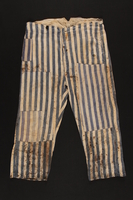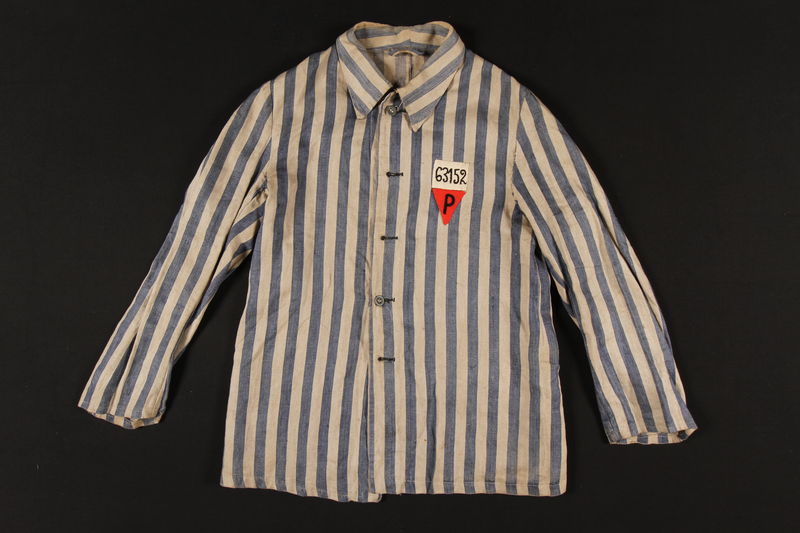Overview
- Brief Narrative
- Blue and white striped uniform jacket with a prisoner number and red triangle badge from Gross-Rosen concentration camp. Upon entry into camp, prisoners’ clothes were often confiscated, and they were issued uniforms. Men received a cap, pants, and a jacket, while women received a dress or skirt with a jacket and kerchief for their head. Prisoners received an identification number, which was often paired with a color-coded triangular badge. Red was for political prisoners, and the “P” on the badge indicates the prisoner was Polish. Most uniforms were made in larger camps such as Dachau, Sachsenhausen, and Ravensbrück, and were then continuously altered for fit by prisoners as their bodies deteriorated physically. By the time Gross-Rosen was established in 1941, blue and gray prisoner uniforms had become standard issue in the concentration camp system. Gross-Rosen was originally a subcamp of Sachsenhausen concentration camp, but was designated as an autonomous camp in 1941. Initially, prisoners constructed the camp and performed hard labor at the nearby granite quarry. Later, the camp expanded to encompass approximately 97 subcamps, and a network of armaments production facilities that utilized forced labor. Camp authorities often beat and abused prisoners while they worked. Prisoners were forced to sleep on vermin infested straw sacks, and were fed watery soup and miniscule portions of bread with a little margarine or horse sausage. In early February 1945, the camp was evacuated ahead of approaching Soviet forces. Many prisoners died during the evacuations, due to lack of food and water. Approximately 120,000 prisoners passed through Gross-Rosen, and 40,000 perished.
- Date
-
issue:
1940 August 02-1945 February 13
- Geography
-
issue:
Gross-Rosen (Concentration camp);
Rogoznica (Wojewodztwo Dolnoslaskie, Poland)
- Credit Line
- United States Holocaust Memorial Museum Collection, Gift of the State Museum of Gross Rosen
Physical Details
- Classification
-
Clothing and Dress
- Category
-
Concentration camp uniforms
- Object Type
-
Jackets (lcsh)
- Genre/Form
- Prison uniforms.
- Physical Description
- Blue and white, vertically striped, hip-length, long-sleeved, medium-weight, herringbone weave cloth jacket. The stripes are woven into the cloth, and the seams are machine stitched with cream-colored thread. The straight collar has pointed tips and is fastened with a silver-colored metal hook and eye closure. The front placket has two blue-gray, plastic, circular buttons stitched to the right side. There is leftover cream-colored thread for three missing buttons, two in-between the remaining buttons, and one below. There are five corresponding, horizontal buttonholes along the left side, finished with black thread. A rectangular, white cloth patch with a five-digit prisoner number embroidered in black thread is stitched to the left breast with white thread. An inverted, red cloth triangle with a capitalized letter embroidered in black thread, is sewn below it with red thread. There is a machine stitched, center seam down the back. On the interior of the jacket, a white and blue cloth hanging loop is sewn to the collar. The jacket is lightly stained overall.
- Dimensions
- overall: Height: 28.000 inches (71.12 cm) | Width: 15.500 inches (39.37 cm)
- Materials
- overall : cloth, thread, plastic, metal
- Inscription
- front, left breast, white patch, embroidered, black thread : 63152
front, left breast, red patch, embroidered, red thread : P
Rights & Restrictions
- Conditions on Access
- No restrictions on access
- Conditions on Use
- No restrictions on use
Keywords & Subjects
- Topical Term
- Concentration camps--clothing and dress--uniforms. Holocaust, Jewish (1939-1945)--Concentration camps.
- Geographic Name
- Rogoźnica (Województwo Dolnośląskie, Poland)
- Corporate Name
- Gross-Rosen (Concentration camp)
Administrative Notes
- Legal Status
- Permanent Collection
- Provenance
- The jacket was donated to the United States Holocaust Memorial Museum in 1992 by the State Museum at Gross Rosen.
- Record last modified:
- 2022-07-28 18:22:05
- This page:
- https://collections.ushmm.org/search/catalog/irn6783
Also in State Museum at Gross Rosen collection
The collection consists of concentration camp uniform pants and jacket relating to Gross-Rosen concentration camp during the Holocaust.
Date: 1940-1945

Concentration camp uniform pants worn by a prisoner
Object
Blue and white striped uniform pants from Gross-Rosen concentration camp. Upon entry into camp, prisoners’ clothes were often confiscated, and they were issued uniforms. Men received a cap, pants, and a jacket, while women received a dress or skirt with a jacket and kerchief for their head. Prisoners received an identification number, which was often paired with a color-coded triangular badge. Red was for political prisoners, and the “P” on the badge indicates the prisoner was Polish. Most uniforms were made in larger camps such as Dachau, Sachsenhausen, and Ravensbrück, and were then continuously altered for fit by prisoners as their bodies deteriorated physically. By the time Gross-Rosen was established in 1941, blue and gray prisoner uniforms had become standard issue in the concentration camp system. Gross-Rosen was originally a subcamp of Sachsenhausen concentration camp, but was designated as an autonomous camp in 1941. Initially, prisoners constructed the camp and performed hard labor at the nearby granite quarry. Later, the camp expanded to encompass approximately 97 subcamps, and a network of armaments production facilities that utilized forced labor. Camp authorities often beat and abused prisoners while they worked. Prisoners were forced to sleep on vermin infested straw sacks, and were fed watery soup and miniscule portions of bread with a little margarine or horse sausage. In early February 1945, the camp was evacuated ahead of approaching Soviet forces. Many prisoners died during the evacuations, due to lack of food and water. Approximately 120,000 prisoners passed through Gross-Rosen, and 40,000 perished.




